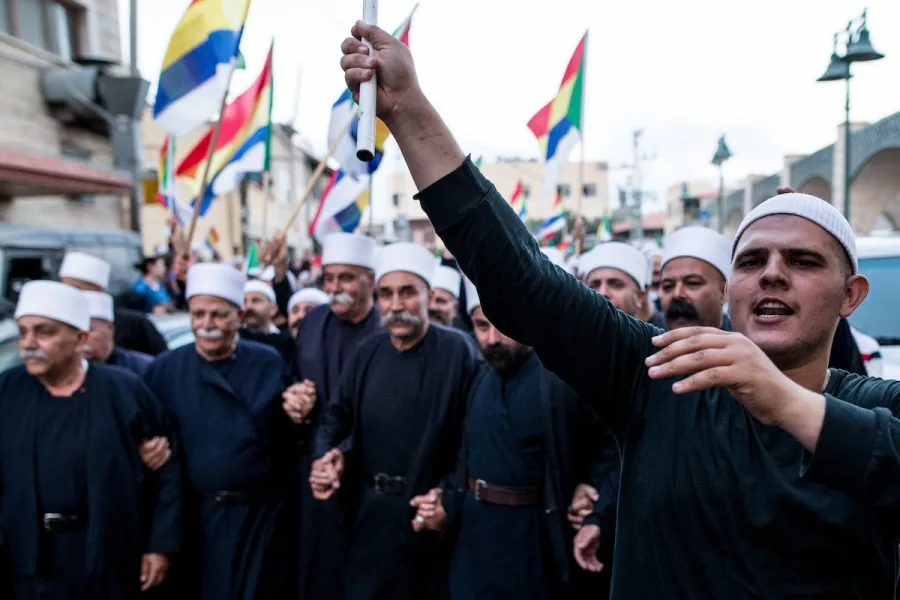The Druze community of Syria represents one of the country’s most distinctive and historically significant minorities. Primarily concentrated in the southern province of Suwayda, this tight-knit ethno-religious group has maintained its unique identity through centuries of political upheaval while playing a crucial role in Syria’s social fabric. With distinctive religious practices, strong communal bonds, and a complex relationship with successive Syrian governments, the Druze continue to navigate the challenges of preserving their heritage amid regional instability.
Origins and Historical Development
The Druze faith emerged in Egypt during the early 11th century during the Fatimid Caliphate. The movement began around 1017 CE when Hamza ibn Ali, along with other followers, proclaimed Fatimid caliph al-Hakim bi-Amr Allah as a divine figure. After al-Hakim’s mysterious disappearance in 1021, the faith developed under the leadership of Hamza and Baha al-Din al-Muqtana. The name “Druze” derives from Muhammad al-Darazi, an early preacher of the faith, though mainstream Druze practitioners prefer the term “Muwahhidun” (Unitarians).
Facing persecution in Egypt, the Druze community migrated northward, eventually establishing strong communities in mountainous regions of the Levant, including present-day Lebanon, Syria, and Israel. These geographical choices were strategic, offering natural protection from religious persecution. In Syria specifically, Druze settlements date back to the 11th century, with major expansion occurring in the 18th century as Druze families from Lebanon moved to the Jabal al-Druze (Mountain of the Druze) region.
During the Ottoman period, the Druze maintained semi-autonomous status in their mountain strongholds. Their most significant historical moment in Syria came during the Great Syrian Revolt (1925-1927), when Druze leader Sultan al-Atrash led a nationalist uprising against French colonial rule. This rebellion established the Druze reputation for fierce independence and secured their place in Syrian nationalist history despite their minority status.
Geographic Distribution and Demographics
Today, Syria’s Druze population is primarily concentrated in the southern Suwayda Governorate (formerly known as Jabal al-Druze), which borders Jordan. This mountainous region has historically served as the community’s stronghold. The Druze also maintain smaller communities in Damascus and in the foothills of Mount Hermon near the Lebanese border.
Demographic estimates suggest the Druze constitute approximately 3-4% of Syria’s pre-war population, numbering between 600,000-700,000 people. However, exact figures are difficult to establish due to the lack of recent census data and population displacement during the Syrian civil war. The community has experienced significant emigration during periods of conflict, creating substantial Druze diaspora communities in Venezuela, the United States, Canada, and Australia.
The Druze have historically maintained distinctive settlement patterns, preferring to live in homogeneous communities or villages clustered around religious sites. This geographic concentration has facilitated the preservation of their cultural identity and religious practices while reinforcing communal solidarity. Major Druze-majority towns in Syria include Suwayda city (the provincial capital), Shahba, Salkhad, and Qanawat.
Religious Beliefs and Practices
The Druze faith represents a unique monotheistic tradition that emerged from Ismaili Islam but incorporates elements of Gnosticism, Neoplatonism, and other philosophical systems. Core theological principles include strict monotheism, belief in the divine manifestation through human form (particularly al-Hakim), reincarnation, and divine justice. The religion features several distinctive concepts:
Tawhid: The absolute oneness of God, which forms the central theological principle
Cyclical history: The belief that history moves through cycles of concealment and revelation
Reincarnation: The soul returns in new bodies until achieving spiritual perfection
Limited conversion: The faith closed its doors to new converts in 1043 CE
Religious practices are notably secretive, with full knowledge of the faith’s teachings restricted to a class of initiates known as uqqal (“the knowledgeable”), while the non-initiated are called juhhal (“the ignorant”). Sacred texts include the Epistles of Wisdom (Rasa’il al-Hikma), though these are accessible only to initiated members.
Unlike mainstream Islamic practice, the Druze do not maintain public mosques or follow the five pillars of Islam. Religious gatherings occur in simple structures called majlis or khalwat, typically on Thursday evenings. These meetings combine spiritual discussion, social connection, and community decision-making. Women have traditionally enjoyed relatively equal religious status within the community, a distinctive feature compared to some other Middle Eastern religious groups.
Language, Culture, and Social Organization
While Arabic serves as the primary language of Syria’s Druze community, their dialect contains distinctive features and vocabulary that reflect their unique cultural heritage. Many Druze are bilingual or multilingual, particularly those with higher education or in urban centers. Their linguistic identity forms part of their broader cultural positioning as both distinctively Druze and integrated within Syrian society.
Druze cultural practices emphasize endogamy (marriage within the community), strong family bonds, and collective responsibility. The community maintains distinctive customs surrounding major life events—birth, marriage, and death—which blend religious significance with social celebration. Traditional clothing, particularly for older generations and in rural areas, sometimes includes distinctive elements like the white turban for religious men (*sheikhs*) and modest, distinctive dress for women.
Social organization revolves around extended family structures and village communities. Leadership traditionally comes from prominent families with religious and historical significance. The concept of asabiyya (group solidarity) remains strong, providing mutual support and protection during difficult times. This community cohesion has been vital for preserving Druze identity through centuries of political uncertainty.
Honor codes emphasizing honesty, loyalty, courage, and hospitality remain important cultural touchstones. The five principles that guide Druze ethics include:
1. Truthfulness in speech
2. Protection of the community
3. Rejection of other religions
4. Disassociation from non-Druze and evil
5. Belief in the unity of God
Political Leadership and Administration
The Syrian Druze community has historically maintained a complex relationship with central authorities, balancing autonomy with integration. Traditional leadership structures combined religious authority (sheikhs) with temporal power held by prominent families. The al-Atrash family gained particular prominence during the anti-French rebellion and maintained significant influence throughout the 20th century.
Under the Assad regime, the Druze have occupied an ambiguous position. While officially integrated into Syria’s political structure through Ba’ath Party representation and military service, they have maintained a degree of communal autonomy in their core territories. The government has typically appointed Druze officials to administer Suwayda Governorate, though ultimate power remains with the central government.
During the Syrian civil war (2011-present), the Druze community initially attempted to maintain neutrality. As conflict intensified, most areas established local protection committees while avoiding direct confrontation with the government. This pragmatic approach reflected both their vulnerable minority status and their historical experience navigating political complexity. Some Druze leaders have advocated for greater regional autonomy while others emphasize Syrian national identity.
The current administrative structure in Druze-majority areas combines formal government institutions with informal community leadership. Religious leaders (mashayikh al-‘aql) continue to hold moral authority, while civil administration operates through government-appointed officials and elected municipal councils. This dual system reflects the community’s ongoing negotiation between distinctiveness and integration.
Education and Cultural Transmission
Education holds particular importance within the Druze community as a means of both social advancement and cultural preservation. Before the Syrian conflict, Druze areas typically maintained higher-than-average literacy rates and educational attainment. Schools in Druze regions follow the national Syrian curriculum but often supplement it with community-specific cultural education outside formal settings.
Higher education has created pathways for Druze integration into professional fields including medicine, engineering, education, and government service. Al-Baath University in Homs and Damascus University have historically enrolled significant numbers of Druze students, while some pursue international education opportunities.
Cultural transmission occurs primarily through family structures, with significant emphasis on teaching children community values, historical narratives, and appropriate social behavior. Religious education follows a differentiated pattern, with basic principles taught broadly while deeper theological understanding remains restricted to initiates. This dual system maintains both community cohesion and religious continuity.
Traditional knowledge transmission includes oral histories, poetry, music, and dance forms unique to the community. The dabke dance tradition holds particular cultural significance during celebrations and gatherings. In recent decades, cultural associations have worked to document and preserve traditional practices while adapting to modern contexts. Digital platforms increasingly supplement traditional methods, connecting diaspora communities with their cultural heritage.
Contemporary Challenges and Resilience
Syria’s protracted conflict has presented existential challenges to the Druze community. While largely spared the worst violence that devastated other regions, Suwayda province has faced economic deterioration, security threats (particularly from ISIS in 2018), and the dilemma of military conscription. Many young Druze have emigrated to avoid service or seek economic opportunities, threatening demographic sustainability.
Despite these challenges, the community demonstrates remarkable resilience. Local governance structures have maintained basic services when central government control weakened. Community solidarity networks provide mutual aid during economic hardship. Cultural practices continue despite displacement, with diaspora communities maintaining connections to their Syrian homeland.
The future of Syria’s Druze community remains uncertain amid ongoing national instability. Their historical experience suggests an ability to adapt while preserving core identity markers. Key challenges include managing relationships with whatever power emerges dominant in Syria, maintaining demographic presence despite emigration pressures, and balancing tradition with modernization. Their continued presence represents both a testament to their resilience and an important component of Syria’s diverse cultural mosaic.


